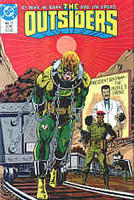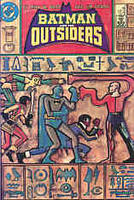The sad news about Jim Aparo’s death hit me surprisingly hard this afternoon. Like most fans, I didn’t know him personally, but his bold, expressive style imprinted itself upon my memory at a time when I was first beginning to appreciate the real artistry of comic book art. Many readers, especially older ones, will no doubt remember Jim as one of the all time great Batman artists. But for me his name will always be synonymous with the work of his later career, and with the characters of his and Mike W. Barr’s superlative anti-Justice League, in particular: Halo, Katana, Black Lightening, Geo-Force, and Metamorpho. I was eleven years old in 1983 when Batman and the Outsiders premiered. I had been officially “collecting” comics for one full year and was looking for something that would compare favorably with Wolfman and Perez’s The New Teen Titans, the comic which had turned me from a sporadic enthusiast into a full time obsessive some twelve months earlier. It would not be an exaggeration to say that Perez was a kind of god to me back then. I was genuinely enthralled by his work. I pored over it for hours, I tried to copy it, and I compared the art in every comic on the stands to the benchmark of his meticulously detailed pencils and complex, impossibly dense layouts. Few were in his league and most didn’t compare at all. I was snob, even back then, which partly accounted for the extremely limited and yet utterly obsessive nature of my devotions.
I was eleven years old in 1983 when Batman and the Outsiders premiered. I had been officially “collecting” comics for one full year and was looking for something that would compare favorably with Wolfman and Perez’s The New Teen Titans, the comic which had turned me from a sporadic enthusiast into a full time obsessive some twelve months earlier. It would not be an exaggeration to say that Perez was a kind of god to me back then. I was genuinely enthralled by his work. I pored over it for hours, I tried to copy it, and I compared the art in every comic on the stands to the benchmark of his meticulously detailed pencils and complex, impossibly dense layouts. Few were in his league and most didn’t compare at all. I was snob, even back then, which partly accounted for the extremely limited and yet utterly obsessive nature of my devotions. Among this handful of devotions was Barr and Aparo’s Batman and the Outsiders. I fell in love with this comic instantly, in large part because of the extraordinary dynamism and emotional expressiveness of Aparo’s art. Compared to the carefully wrought beauty of Perez’s storytelling, Aparo’s synthesis of moody realism and “cartoonish” intensity held an almost primitive vitality to me. I still find its arresting blend of angularity, realism, movement, and grace difficult to describe with any degree of precision. But I loved it.
Among this handful of devotions was Barr and Aparo’s Batman and the Outsiders. I fell in love with this comic instantly, in large part because of the extraordinary dynamism and emotional expressiveness of Aparo’s art. Compared to the carefully wrought beauty of Perez’s storytelling, Aparo’s synthesis of moody realism and “cartoonish” intensity held an almost primitive vitality to me. I still find its arresting blend of angularity, realism, movement, and grace difficult to describe with any degree of precision. But I loved it.
The best I can say is that its appearance in my little world at this moment in 1983 felt like a blast of fresh air into a beautifully furnished but slightly stuffy apartment. It provided, in my own very private history of images, a sort of welcome jolt. And I imagine that the feeling was not entirely unlike the one produced on a much broader scale by the sudden appearance of a work like Edvard Munch’s The Scream (1893) to a nineteenth-century audience that was used to a certain degree of polite decorum in their art. With no disrespect to the genius of Perez, my discovery of Jim Aparo was a turning point in the maturation of my aesthetic tastes because it changed my understanding of the expressive range and potential of comic book art. Before this point, only the creep-inducing weirdness of Gene Colan’s work on Night Force had given me a hint of this potential, but Colan’s work (which is in reality much closer to Munch’s expressionism than Aparo’s) was too grotesque and challenging for me to fully appreciate at age eleven; although I was attracted to it, it was “ugly” in a way that I wasn’t quite ready for back then. Aparo’s art, though, occupied a sort of middle ground between Perez’s “realistic” dynamism and Colan’s more extreme expressionism, and it was for me the point of entry into later passions like the work of Colan or of the Hernandez Bros. (especially Gilbert) whose human figures, strange as it sounds, still remind me in certain ways of Aparo’s.
With no disrespect to the genius of Perez, my discovery of Jim Aparo was a turning point in the maturation of my aesthetic tastes because it changed my understanding of the expressive range and potential of comic book art. Before this point, only the creep-inducing weirdness of Gene Colan’s work on Night Force had given me a hint of this potential, but Colan’s work (which is in reality much closer to Munch’s expressionism than Aparo’s) was too grotesque and challenging for me to fully appreciate at age eleven; although I was attracted to it, it was “ugly” in a way that I wasn’t quite ready for back then. Aparo’s art, though, occupied a sort of middle ground between Perez’s “realistic” dynamism and Colan’s more extreme expressionism, and it was for me the point of entry into later passions like the work of Colan or of the Hernandez Bros. (especially Gilbert) whose human figures, strange as it sounds, still remind me in certain ways of Aparo’s.
More than any other artist at that time, Aparo’s art made me feel the raw emotion of the characters. There is an incredible joy that permeates his work on BATO, most obviously in his luminous drawings of Halo. Aparo could draw happiness that you believed, and current artists could learn a lot from the grin he occasionally bestowed on Batman.  In many ways, however, he seemed most at home as an artist of tragedy. The bent, crouching bodies of his mourning figures were unlike any depiction of suffering I had ever seen; they seemed nearly to melt into the page, as if their anguish was literally wrenching them apart. His tortured Metamorpho, for instance, or Katana, when she encounters the ghost of her dead husband. Only Perez had moved me with suffering this grandly, and not even his work conveyed these particular tones of grief. There was certainly no better artist with which to entrust the depiction of Jason Todd’s death many years later.
In many ways, however, he seemed most at home as an artist of tragedy. The bent, crouching bodies of his mourning figures were unlike any depiction of suffering I had ever seen; they seemed nearly to melt into the page, as if their anguish was literally wrenching them apart. His tortured Metamorpho, for instance, or Katana, when she encounters the ghost of her dead husband. Only Perez had moved me with suffering this grandly, and not even his work conveyed these particular tones of grief. There was certainly no better artist with which to entrust the depiction of Jason Todd’s death many years later.
Beyond the sheer expressiveness of his figures, Aparo was also a superb draftsman, and this was particularly evident in his covers. Over the next few years, I became fixated on Aparo’s BATO and Outsiders covers, and I would routinely spread my copies of these titles over my bedroom floor to pick out my ever changing favorites.  Among the covers I liked best were invariably the ones that were the least conventional, and of these there were a great many to choose from. Aparo clearly reveled in the creative control he enjoyed on BATO and its later Batman-free “Baxter” version, and he produced a number of covers that challenged the conventions of superhero cover art in exciting ways. The painted “hieroglyphic” image of Metamorpho battling the team in Egypt from BATO #17, or the image of Rex as Pharaoh being traced in sand that adorns the subsequent issue, were the work of an artist at the peak of his creative powers. To my parents’ enormous consternation, I liked to hang bagged and boarded comics from nails on my bedroom walls just like in the comic store. Not surprisingly, these Aparo covers were perennial favorites.
Among the covers I liked best were invariably the ones that were the least conventional, and of these there were a great many to choose from. Aparo clearly reveled in the creative control he enjoyed on BATO and its later Batman-free “Baxter” version, and he produced a number of covers that challenged the conventions of superhero cover art in exciting ways. The painted “hieroglyphic” image of Metamorpho battling the team in Egypt from BATO #17, or the image of Rex as Pharaoh being traced in sand that adorns the subsequent issue, were the work of an artist at the peak of his creative powers. To my parents’ enormous consternation, I liked to hang bagged and boarded comics from nails on my bedroom walls just like in the comic store. Not surprisingly, these Aparo covers were perennial favorites.
What Jim Aparo meant to me is quite personal, and something that is difficult to put into words without sounding maudlin or self-dramatizing. It’s hard to separate his work in my mind from Perez’s because The New Teen Titans and Batman and the Outsiders were my comics. The first two titles that I poured myself into completely, disappearing until there was nothing left but vectors of color, motion, and affect.
Like George Perez, he was an artist whose work I love and admire. But he is a belated artist, an artist who appeared (for me) after my tastes had already to some extent crystallized. For this reason, his work is simultaneously both stranger and more profound than Perez’s. It is associated in my mind with increased maturity, with the unruliness of emotion, with real joy and real agony. I love the innocence of his work on the Outsiders. I love the joy that permeates the “cartoonishness” of his work and punctures the solid base of realism that subtends it and with which it competes.
But I love his anguished figures most of all. These tragic figures temper the euphoria of his comedy, and there’s a raw honesty about them, an unforgiving truthfulness about the absolute finality of loss. These images make the joy that animates his style all the more astonishing and wonderful in its affirmation. For this reason, I don’t think it would be out of place to call Jim Aparo a Nietzschean artist, an artist of “joyful wisdom.” That, at least, is how I will think of him.
Related Links
Tuesday, July 19, 2005
In Memoriam: What Jim Aparo Meant to Me
Subscribe to:
Post Comments (Atom)




4 comments:
I, too, am a fan of Aparo's work. To me he was The DC Universe's artist.
Hi Devon--
sorry for not replying before--I sort of lost track of this post. Just wanted to say that I really liked your own tribute to Aparo over on "Seven Hells!" I didn't know that BATO was a "gateway" comic, but it certainly makes sense (and Aparo's art must have had a lot to do with that). Thanks for stopping by!
I also am a Jim Aparo fan, His great work in the 70's I actually find superior to Neal Adams. I grew up with his fearsome/legendary run of the Specter (Which I used to read over and over) and of course The Phantom Stranger which I recently rediscovered and have been enjoying thru the treasure of back issues. But of course his greatest feat is the luster and craft he added to the legacy of The Batman! Jim Aparo really defined him and his name should be added to the roll call of elite contributors/artists who made batman what he is today: Adams, Rodgers, Sprang, Finger, Englehart,Giordiano,etc. Some people ask me if I read comics because its a way of being in touch with my childhood. I generally say no. However when I read a Jim Aparo Brave and the Bold then I have to say yes! I am instantly transported to my childhood summers, relaxing by the swimming pool reading a Batman/Mr Miracle adventure! Huzzah Jim!
-Morgan Butler
Just found your post while looking for websites interested in exchanging blog links.
I have always been a fan of Jim Aparo but have only recently had the chance to read more original material through DC´s SHOWCASE volume of PHANTOM STRANGER, the SPECTRED trade and now the spanish comic company PLANETA doing a special edition of his work on THE BRAVE AND THE BOLD.
I even started a series on my own blog ( that I have to continue some day ) about it :
http://talesfromthekryptonian.blogspot.com/search/label/classicos%20dc
P.S. And if you interested in a blog link exchange......
Post a Comment